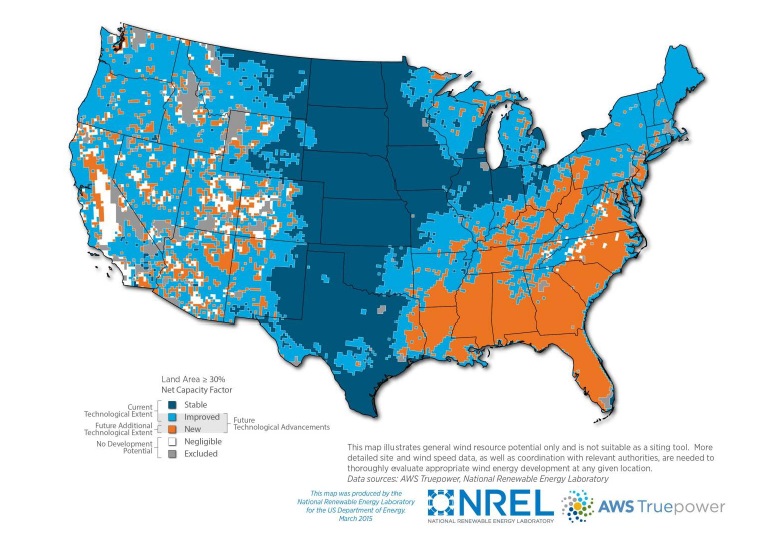This article is the Executive Summary from the DOE report, Enabling wind power nationwide, the full report is available here: energy.gov/windvision
Today, wind energy provides nearly 5% of the nation’s total electricity generation. With 65 gigawatts (GW) deployed, utility-scale installations in 39 states, and wind power generation exceeding 12% in 11 of those states, wind is a demonstrated clean, affordable electricity resource for the nation. Research and industry experience indicate that wind can be deployed at higher levels while maintaining grid reliability.

The dark blue identifies high quality wind resource areas that see no change in available land area meeting the 30% minimum net capacity factor threshold with technology advancement because the entire area is capable of achieving this threshold today. Light blue identifies areas that meets the capacity factor threshold today but foresees a larger portion of the area able to achieve this threshold as a result of turbine and hub height improvements. Orange identifies new land area able to achieve the minimum 30% net capacity factor level as a result of turbine and hub height improvements.
Leveraging this experience, the U.S. Department of Energy’s (DOE’s) Wind and Water Power Technologies Office has evaluated the potential for wind power to generate electricity in all 50 states. DOE analyzed the potential for expanding use of wind nationwide, concluding:
- The United States has vast wind resources across all 50 states. Continued advancements in turbine technology–including those that enable higher hub heights, larger rotors, and improved energy capture–can access the stronger and more consistent wind resources typically found at greater heights above ground level They also enable wind to be a true nationwide economic resource;
- Advancements in wind technologies have already yielded broad cost-competitive deployment in locations with high wind speeds. Market trends and technological innovations are increasingly unlocking cost-effective wind in regions with more moderate wind resources;
- Based on an advanced turbine concept and assuming hub heights of 110 meters (m) (which are already in wide commercial deployment in Germany and other European countries), the technical potential for wind deployment is estimated to grow to 4.3 million square kilometers, a 54% increase compared to current technology with 80-m hub heights. By pursuing hub heights of 140 m, the technical potential for wind deployment is estimated to grow to 4.6 million square kilometers, a 67% increase compared to current technology with 80-m hub heights (Figure ES-1). The geographic distribution for this expanded wind technical resource would include new regions such as the Southeast, as well as increasing the already cost-effective areas where wind power is currently installed; and
- Improvements in siting practices have contributed to the deployment of 65 GW in cumulative installed wind capacity (as of 2014). Pursuing more moderate resource quality sites can and should be done in coordination with the broad stakeholder community for wind to coexist with the environment and federal and state agency missions.
The report analyzes and quantifies the geographic expansion that could be enabled by accessing higher above ground heights for wind turbines and considers the means by which this new potential could be responsibly developed. This report describes the current state of wind technology and transportation considerations, and details future technology pathways for technical innovation in towers, rotors, drive trains, and component transport and installation. As wind turbines become larger, with taller towers and longer blades, transportation logistics become increasingly complex. For example, the height of bridges limits the diameter of towers that can be transported by truck. Innovations to address these challenges include on-site manufacturing, modular components, and new materials and designs for larger systems.
As wind deployment reaches new heights and new regions, additional environmental and human use factors will need to be considered and addressed. This includes the potential for new or additional interactions with wildlife such as birds and bats, as well as effects on their habitats. Additionally, impacts related to human use concerns, such as civilian and military radars, must be also evaluated. Continued research and development, as well as federal, state and local inter-agency coordination, on potential impacts and options for mitigation and resolution are required to ensure responsible deployment.
Several federal agencies have activities currently underway that will support efforts to enable -wind power nationwide. For instance, the Federal Aviation Administration is creating lighting guidelines for wind turbines with total heights above 500 feet. In addition, the DOE has recently announced Funding Opportunity Announcements targeting innovative research and development solutions addressing taller towers and larger rotors.
Pursuing higher hub heights can truly enable wind to be deployed across all 50 states. As can be seen in DOE’s report, Wind Vision: A New Era for Wind Power in the United States
(DOE 2015)1, there are significant economic and societal benefits that come from wind energy. The Wind Vision report calculated the economic and societal value for future wind scenarios, and included economic calculations as well as quantification of societal impacts, such as greenhouse gases (GHGs), pollutants and water use. The report found that wind delivered a wide range of societal benefits, such as reductions in GHG emissions and water consumption. Central estimates for the value of GHG benefits in the Wind Vision Study Scenario analysis were $125 billion through 2030, air pollutant reductions were $42 billion through 2030, and water consumption reductions were 173 billion gallons per year in 2030. In addition, wind is estimated to support 375,000 jobs in 2030 and $1.8 billion in local tax and lease revenues in 2030.
The deployment of taller wind turbines (already prevalent in Germany with average hub heights at 116 m) will expand U.S. land area available for wind deployment by 54%. Further innovation and increasing heights to 140 m will increase that further to 67%. Innovations addressing the technical and economic challenges, as well as the environmental and human use considerations, are critical to realize the nation’s full wind power potential and value for all 50 states as described in this report.
Filed Under: News, Policy




